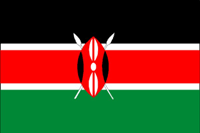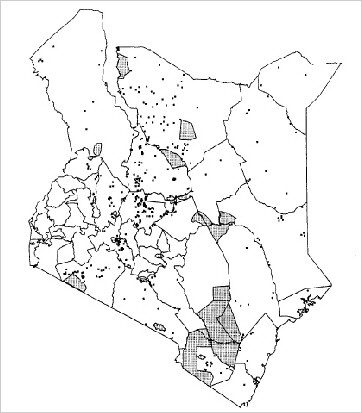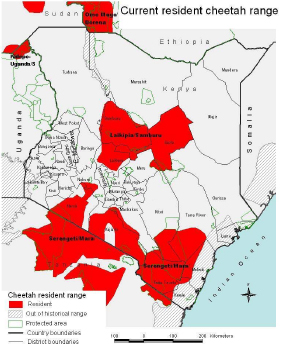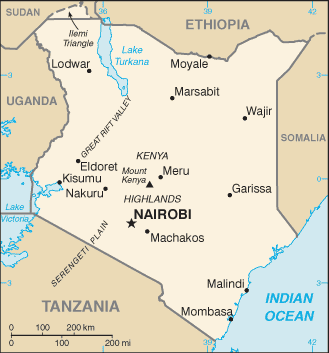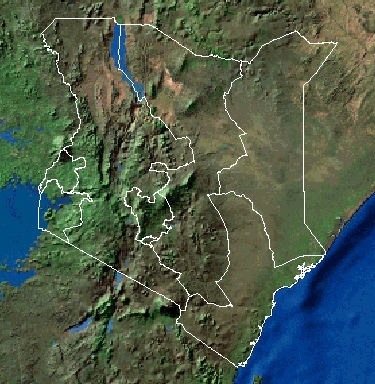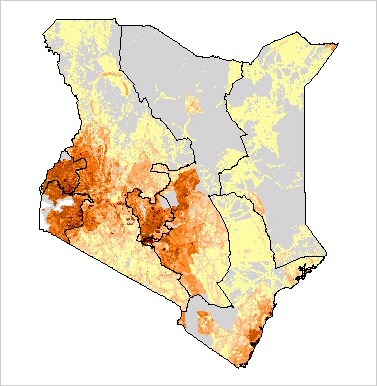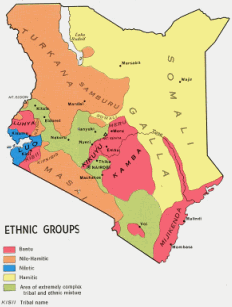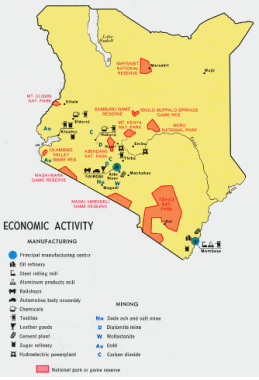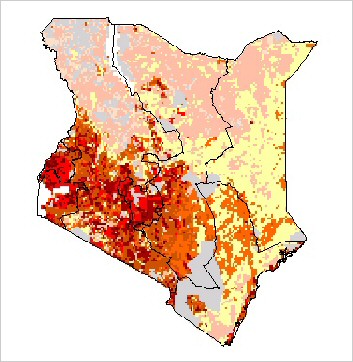|
|
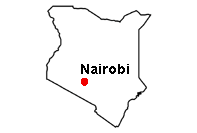 |
| |
back to top | ||||
|
|||||
|
|
|
| Founding president and liberation struggle icon Jomo KENYATTA led Kenya from independence in 1963 until his death in 1978, when President Daniel Toroitich arap MOI took power in a constitutional succession. The country was a de facto one-party state from 1969 until 1982 when the ruling Kenya African National Union (KANU) made itself the sole legal party in Kenya. MOI acceded to internal and external pressure for political liberalization in late 1991. The ethnically fractured opposition failed to dislodge KANU from power in elections in 1992 and 1997, which were marred by violence and fraud, but were viewed as having generally reflected the will of the Kenyan people. President MOI stepped down in December 2002 following fair and peaceful elections. Mwai KIBAKI, running as the candidate of the multiethnic, united opposition group, the National Rainbow Coalition (NARC), defeated KANU candidate Uhuru KENYATTA and assumed the presidency following a campaign centered on an anticorruption platform. KIBAKI's NARC coalition splintered in 2005 over the constitutional review process. Government defectors joined with KANU to form a new opposition coalition, the Orange Democratic Movement, which defeated the government's draft constitution in a popular referendum in November 2005. | |
| |
back to top |
|
Area: total: 582,650 sq km; land: 569,250 sq km; water: 13,400 sq km Climate: varies from tropical along coast to arid in interior Terrain: low plains rise to central highlands bisected by Great Rift Valley; fertile plateau in west Natural resources: limestone, soda ash, salt, gemstones, fluorspar, zinc, diatomite, gypsum, wildlife, hydropower Land use: arable land: 8.01%; permanent crops: 0.97%; other: 91.02% (2001) Irrigated land: 670 sq km (1998 est.) Natural hazards: recurring drought; flooding during rainy seasons Environment-current issues: water pollution from urban and industrial wastes; degradation of water quality from increased use of pesticides and fertilizers; water hyacinth infestation in Lake Victoria; deforestation; soil erosion; desertification; poaching Environment-international agreements: party to: Biodiversity, Climate Change, Climate Change-Kyoto Protocol, Desertification, Endangered Species, Hazardous Wastes, Law of the Sea, Marine Dumping, Marine Life Conservation, Ozone Layer Protection, Ship Pollution, Wetlands, Whaling signed, but not ratified: none of the selected agreements Geography - note: the Kenyan Highlands comprise one of the most
successful agricultural production regions in Africa; glaciers are found on
Mount Kenya, Africa's second highest peak; unique physiography supports
abundant and varied wildlife of scientific and economic value |
|
|
|
|
| |
back to top | |
|
Population: 34,707,817 Age structure: 0-14 years: 42.6% (male 7,454,765/female 7,322,130); 15-64 years: 55.1% (male 9,631,488/female 9,508,068); 65 years and over: 2.3% (male 359,354/female 423,012) (2006 est.) Median age: total: 18.2 years; male: 18.1 years; female: 18.3 years (2006 est.) Population growth rate: 2.57% (2006 est.) Infant mortality rate: total: 59.26 deaths/1,000 live births; male: 61.92 deaths/1,000 live births; female: 56.54 deaths/1,000 live births (2006 est.) Life expectancy at birth: total population: 48.93 years; male: 49.78 years; female: 48.07 years (2006 est.) Total fertility rate: 4.91 children born/woman (2006 est.) |
|
|
|
HIV/AIDS - adult prevalence rate: 6.7% (2003 est.) HIV/AIDS - people living with HIV/AIDS: 1.2 million (2003 est.) HIV/AIDS - deaths: 150,000 (2003 est.) Major infectious diseases: degree of risk: very high; food or waterborne diseases: bacterial and protozoal diarrhea, hepatitis A, and typhoid fever; vectorborne disease: malaria is a high risk in some locations; water contact disease: schistosomiasis (2005) |
||
|
Ethnic
groups: Kikuyu 22%, Luhya 14%, Luo 13%, Kalenjin 12%, Kamba
11%, Kisii 6%, Meru 6%, other African 15%, non-African (Asian, European, and
Arab) 1% Religions: Protestant 45%, Roman
Catholic 33%, indigenous beliefs 10%, Muslim 10%, other 2% Languages: English (official), Kiswahili (official), numerous indigenous languages Literacy: definition: age 15 and over can read and write; total population: 85.1%; male: 90.6%; female: 79.7% (2003 est.) |
|
| back to top | |
|
|
|
|
Data code: KE Government type: republic Independence: 12 December 1963 (from UK) Legal system: based on Kenyan statutory law, Kenyan and English common law, tribal law, and Islamic law; judicial review in High Court; accepts compulsory ICJ jurisdiction, with reservations; constitutional amendment of 1982 making Kenya a de jure one-party state repealed in 1991 Political pressure groups and leaders: human rights groups; labor unions; Muslim organizations; National Convention Executive Council or NCEC, a proreform coalition of political parties and nongovernment organizations [Kivutha KIBWANA]; Protestant National Council of Churches of Kenya or NCCK [Mutava MUSYIMI]; Roman Catholic and other Christian churches; Supreme Council of Kenya Muslims or SUPKEM [Shaykh Abdul Gafur al-BUSAIDY] |
|
| |
back to top |
|
Economy-overview: The regional hub for trade and finance in East Africa, Kenya has been hampered by corruption and by reliance upon several primary goods whose prices have remained low. In 1997, the IMF suspended Kenya's Enhanced Structural Adjustment Program due to the government's failure to maintain reforms and curb corruption. A severe drought from 1999 to 2000 compounded Kenya's problems, causing water and energy rationing and reducing agricultural output. As a result, GDP contracted by 0.2% in 2000. The IMF, which had resumed loans in 2000 to help Kenya through the drought, again halted lending in 2001 when the government failed to institute several anticorruption measures. Despite the return of strong rains in 2001, weak commodity prices, endemic corruption, and low investment limited Kenya's economic growth to 1.2%. Growth lagged at 1.1% in 2002 because of erratic rains, low investor confidence, meager donor support, and political infighting up to the elections. In the key 27 December 2002 elections, Daniel Arap MOI's 24-year-old reign ended, and a new opposition government took on the formidable economic problems facing the nation. In 2003, progress was made in rooting out corruption and encouraging donor support. GDP grew 5% in 2005. |
|
|
GDP - real growth rate: 5.2% (2005 est.) GDP - composition by sector: agriculture: 16.3%; industry: 18.8%; services: 65.1% (2004 est.) Labor force: 11.85 million (2005 est.) Labor force-by occupation: agriculture 75% (2003 est.) Unemployment rate: 40% (2001 est.) Population below poverty line: 50% (2000 est.) Agriculture-products: tea, coffee, corn, wheat, sugarcane, fruit, vegetables; dairy products, beef, pork, poultry, eggs Industries: small-scale consumer goods (plastic, furniture, batteries, textiles, soap, cigarettes, flour), agricultural products; oil refining, aluminum, steel, lead, cement; commercial ship repair, tourism Exports: $3.173 billion f.o.b. (2005 est.) Exports-commodities: tea, horticultural products, coffee, petroleum products, fish, cement Exports-partners: Uganda 13.2%, UK 11.3%, US 10.5%, Netherlands 8.1%, Egypt 4.8%, Tanzania 4.4%, Pakistan 4.3% (2004) |
|
|
Imports: $5.126 billion f.o.b. (2005 est.) Imports-commodities: machinery and transportation equipment 31%, consumer goods 13%, petroleum products 12% (1995) Imports-partners: UAE 12.5%, Saudi Arabia 9.1%, South Africa 8.7%, US 7.7%, India 7.2%, UK 6.7%, China 6.4%, Japan 5% (2004) Currency (code): Kenyan shilling (KES) Exchange rates: Kenyan shillings per US dollar - 75.554 (2005), 79.174 (2004), 75.936 (2003), 78.749 (2002), 78.563 (2001) |
|
| |
back to top |
|
Telephone system: domestic: trunks are primarily microwave radio relay; business data commonly transferred by a very small aperture terminal (VSAT) system international: country code - 254; satellite earth stations - 4 Intelsat Radio broadcast stations: AM 24, FM 18, shortwave 6 (2001) Television broadcast stations: 8 (2002) Internet country code: .ke Internet hosts: 8,325 (2003) Internet users: 400,000 (2002) |
|
|
|
|
|
Gros P.M. 1998. Status of the cheetah Acinonyx jubatus in Kenya: a field-interview assessment. Biological Conservation 85, 137-149. Marker L., Malouf J. and Malouf A., 1999. Appendix 2: The status of the wild cheetah in its range countries. In: 1999 International Cheetah Studbook. http://www.cia.gov/cia/publications/factbook/geos/ke.html (last update on 29 March, 2006) |
|
